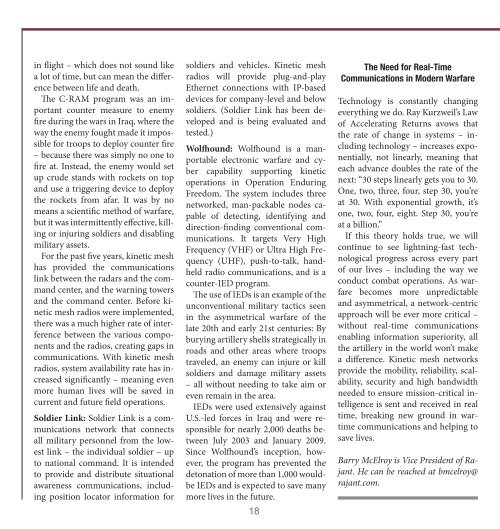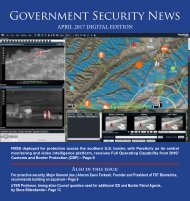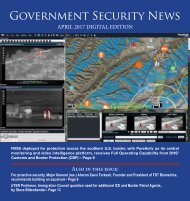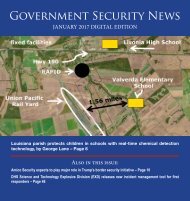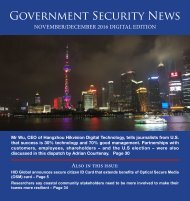GSN_Oct_YUMPU
Create successful ePaper yourself
Turn your PDF publications into a flip-book with our unique Google optimized e-Paper software.
in flight – which does not sound like<br />
a lot of time, but can mean the difference<br />
between life and death.<br />
The C-RAM program was an important<br />
counter measure to enemy<br />
fire during the wars in Iraq, where the<br />
way the enemy fought made it impossible<br />
for troops to deploy counter fire<br />
– because there was simply no one to<br />
fire at. Instead, the enemy would set<br />
up crude stands with rockets on top<br />
and use a triggering device to deploy<br />
the rockets from afar. It was by no<br />
means a scientific method of warfare,<br />
but it was intermittently effective, killing<br />
or injuring soldiers and disabling<br />
military assets.<br />
For the past five years, kinetic mesh<br />
has provided the communications<br />
link between the radars and the command<br />
center, and the warning towers<br />
and the command center. Before kinetic<br />
mesh radios were implemented,<br />
there was a much higher rate of interference<br />
between the various components<br />
and the radios, creating gaps in<br />
communications. With kinetic mesh<br />
radios, system availability rate has increased<br />
significantly – meaning even<br />
more human lives will be saved in<br />
current and future field operations.<br />
Soldier Link: Soldier Link is a communications<br />
network that connects<br />
all military personnel from the lowest<br />
link – the individual soldier – up<br />
to national command. It is intended<br />
to provide and distribute situational<br />
awareness communications, including<br />
position locator information for<br />
soldiers and vehicles. Kinetic mesh<br />
radios will provide plug-and-play<br />
Ethernet connections with IP-based<br />
devices for company-level and below<br />
soldiers. (Soldier Link has been developed<br />
and is being evaluated and<br />
tested.)<br />
Wolfhound: Wolfhound is a manportable<br />
electronic warfare and cyber<br />
capability supporting kinetic<br />
operations in Operation Enduring<br />
Freedom. The system includes three<br />
networked, man-packable nodes capable<br />
of detecting, identifying and<br />
direction-finding conventional communications.<br />
It targets Very High<br />
Frequency (VHF) or Ultra High Frequency<br />
(UHF), push-to-talk, handheld<br />
radio communications, and is a<br />
counter-IED program.<br />
The use of IEDs is an example of the<br />
unconventional military tactics seen<br />
in the asymmetrical warfare of the<br />
late 20th and early 21st centuries: By<br />
burying artillery shells strategically in<br />
roads and other areas where troops<br />
traveled, an enemy can injure or kill<br />
soldiers and damage military assets<br />
– all without needing to take aim or<br />
even remain in the area.<br />
IEDs were used extensively against<br />
U.S.-led forces in Iraq and were responsible<br />
for nearly 2,000 deaths between<br />
July 2003 and January 2009.<br />
Since Wolfhound’s inception, however,<br />
the program has prevented the<br />
detonation of more than 1,000 wouldbe<br />
IEDs and is expected to save many<br />
more lives in the future.<br />
18<br />
The Need for Real-Time<br />
Communications in Modern Warfare<br />
Technology is constantly changing<br />
everything we do. Ray Kurzweil’s Law<br />
of Accelerating Returns avows that<br />
the rate of change in systems – including<br />
technology – increases exponentially,<br />
not linearly, meaning that<br />
each advance doubles the rate of the<br />
next: “30 steps linearly gets you to 30.<br />
One, two, three, four, step 30, you’re<br />
at 30. With exponential growth, it’s<br />
one, two, four, eight. Step 30, you’re<br />
at a billion.”<br />
If this theory holds true, we will<br />
continue to see lightning-fast technological<br />
progress across every part<br />
of our lives – including the way we<br />
conduct combat operations. As warfare<br />
becomes more unpredictable<br />
and asymmetrical, a network-centric<br />
approach will be ever more critical –<br />
without real-time communications<br />
enabling information superiority, all<br />
the artillery in the world won’t make<br />
a difference. Kinetic mesh networks<br />
provide the mobility, reliability, scalability,<br />
security and high bandwidth<br />
needed to ensure mission-critical intelligence<br />
is sent and received in real<br />
time, breaking new ground in wartime<br />
communications and helping to<br />
save lives.<br />
Barry McElroy is Vice President of Rajant.<br />
He can be reached at bmcelroy@<br />
rajant.com.


